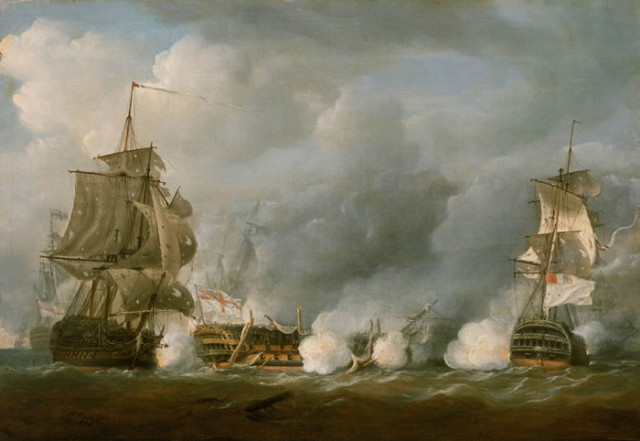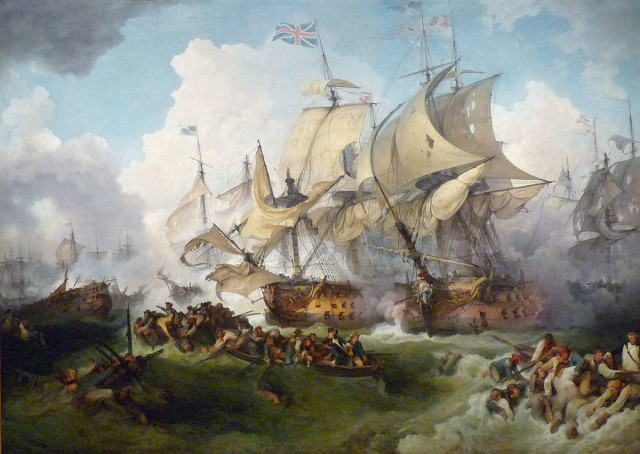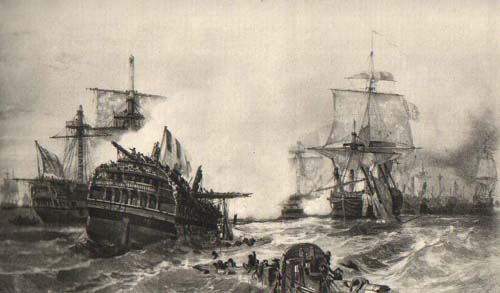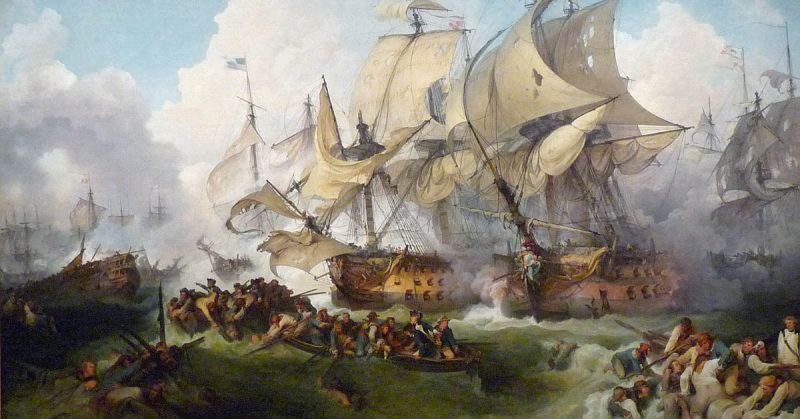The Glorious First of June broke one of the rules by which we understand battles – that there can be only one winner. After the French and British fleets fought on 1 June 1795 – the first and largest naval battle between them in the Revolutionary Wars – both would claim strategic victory.
This was no mere propaganda sleight of hand. Though bloodied and battered, both fleets had good reason to believe that they had met their aims.
Build Up to Battle
The French Revolutionary War began in 1792, when the French, caught up in the huge social and political upheavals of revolution, went to war with Austria and Prussia. It was a war about France’s new values as well as the traditional concerns of protecting or expanding borders.
In 1793, growing tensions and the execution of the French King Louis XVI, who was replaced by a republic, brought Britain and the Dutch Republic into the war. With the English Channel between them and France, the British were less involved with the war than their allies, though they contributed troops to failed attempts to hold Toulon alongside French monarchist rebels and detachments from other nations.
There had been some clashes at sea, and the Siege of Toulon ended with the British destroying French naval stores. But there was no great fleet confrontation until 1794.

Meanwhile, France was starving. War, poor harvests and a ruined economy were causing huge supply problems. The government resolved to fix this by gathering supplies from its colonies and the United States, loading them up in a fleet of merchant vessels at Chesapeake Bay, and sailing the supplies across the Atlantic under armed escort.
The British intended to intercept.
The British Fleet
The British fleet had been on a war footing for three years and was well prepared for confrontation. The forces confronting the French were numerically superior, though without such large, heavy ships as the French fielded, or the heavier shot they were equipped with.
British dockyards were churning out ships and supplies, but a lack of manpower hampered the fleet. Press gangs forcefully recruited in coastal towns, but this meant crews full of inexperienced and unhappy sailors. Royal Marines, who played a crucial role once the ships got close, were in short supply, with infantry regiments filling the gaps.
The British were led by Earl Howe, one of the finest naval commanders of the age.
The French Fleet
The French, in contrast, were in disarray. Shortage of supplies had led to a mutiny the previous year, after which many sailors and officers were imprisoned or executed. This came on top of losses suffered during the political purges of the revolutionary Terror, when political extremists took out those they suspected of monarchic leanings or of betraying France.
As a result, many of the men and officers of the fleet were inexperienced. Their commander, Louis Thomas Villaret de Joyeuse, was relatively green but tactically smart. He was hindered by the presence of Jean-Bon Saint-André, a deputy from the National Convention tasked with keeping the fleet and its crews in line politically. Saint-André boosted the fleet’s public standing but meddled with Villaret’s decisions.
The Fleets Engage
In May 1794, with the merchant convoy on its way, Villaret set out from France to keep the British occupied. For several weeks, the two military fleets manoeuvred around the Atlantic. From 25 May there were minor clashes between them, the result of which was that the British had the weather gage –the advantageous position of being upwind. The merchant fleet was now nearby.

At dawn on 1 June, Villaret was manoeuvring to make an escape, drawing the British away from the supply fleet. Only hours away from being able to get away, he now found Howe closing on him. The two fleets gradually came closer together, opening fire just before half past nine in the morning.
At first, both fleets followed conventional tactics, forming parallel lines of ships that bombarded each other from a distance. This was the way most naval battles of the era were fought.
But Howe had a more daring plan.
Breaking the Line
Howe intended to break the French line. Making using of his advantageous position in relation to the wind, the ships were all to follow the lead he set in the HMS Queen Charlotte, turning towards the French line. They would suffer a period of bombardment when the French broadsides could reach them but their main guns were facing the wrong way.
Once they reached the enemy they would sail between the French ships, reversing the position of a moment before, with the advantage of firing at close range. The enemy formation would be broken, the British would inflict a great deal of damage, and on reaching the far side they would be able to block any French retreat.
The plan was imperfectly executed, through no fault of Howe’s. A number of British captains ignored his orders, continuing to sail alongside the French and bombard them at long or close range.
The ships that followed orders cut through the French line, unleashing devastating barrages, but the effect was incomplete.
Chaos and Retreat

The battle descended into a jumbled mess of close-range fire and boarding actions, all sense of formation lost. The HMS Gibraltar, one of the disobedient British ships, fired wildly into the smoke around the French flagship and hit Queen Charlotte.
Despite the actions of his many of his officers, Howe’s manoeuvre had worked, and the British inflicted far more damage than they received. After two hours, Villaret managed to pull a dozen ships out of the combat and reform. Many of the British ships had lost their masts or had captured French ships which they now needed to deal with. Howe therefore reformed rather than pursue, letting the French retreat.
Claiming Victory
Both sides claimed victory.
For Villaret, the win was easy to define. While he occupied the British, the vital convoy had got through.
For Howe, it came in two parts. His fleet had captured or sunk seven French ships and forced the enemy to retreat. On top of this, the damage to the French left Britain in control of the seas, able to blockade French ports.
It was a battle that both sides had won.
